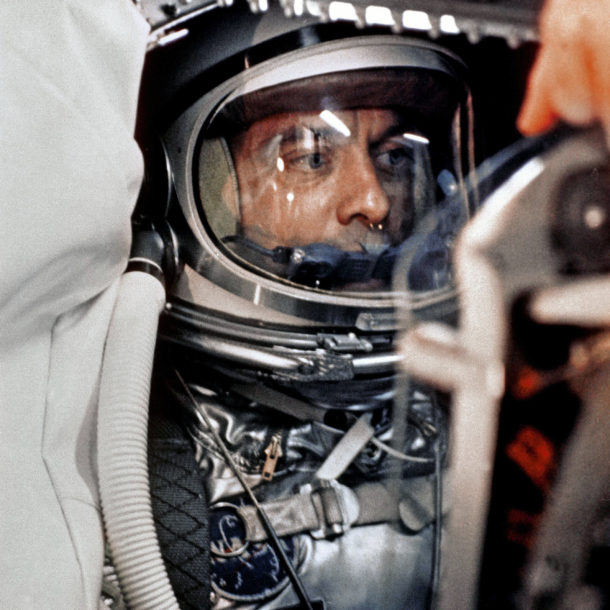
Fifty-nine years ago today, United States Navy Commander Alan Bartlett Shepard, Jr. became the first American to be launched into space. Shepard named his Mercury spacecraft Freedom 7.
Officially designated as Mercury-Redstone 3 (MR-3) by NASA, the mission was America’s first true attempt to put a man into space. MR-3 was a sub-orbital flight. This meant that the spacecraft would travel along an arcing parabolic flight path having a high point of about 115 nautical miles and a total range of roughly 300 nautical miles. Total flight time would be about 15 minutes.
The Mercury spacecraft was designed to accommodate a single crew member. With a length of 9.5 feet and a base diameter of 6.5 feet, the vehicle was less than commodious. The fit was so tight that it would not be inaccurate to say that the astronaut wore the vehicle. Suffice it to say that a claustrophobic would not enjoy a trip into space aboard the spacecraft.
Despite its diminutive size, the 2,500-pound Mercury spacecraft (or capsule as it came to be referred to) was a marvel of aerospace engineering. It had all the systems required of a space-faring craft. Key among these were flight attitude, electrical power, communications, environmental control, reaction control, retro-fire package, and recovery systems.
The Redstone booster was an Intermediate Range Ballistic Missile (IRBM) modified for the manned mission. The Redstone’s up-rated A-7 rocket engine generated 78,000 pounds of thrust at sea level. Alcohol and liquid oxygen served as propellants. The Mercury-Redstone combination stood 83 feet in length and weighed 66,000 pounds at lift-off.
On Friday, 05 May 1961, MR-3 and her one man crew stood poised for launch from Cape Canaveral’s Launch Complex 5. However, as was so often the case in the early days of manned spaceflight, there were numerous glitch-related holds in the countdown. Strapped into his seat and with the hatch bolted shut, Shepard had to patiently endure hours of waiting while each glitch was resolved. In fact, the astronaut had to wait so long that he was finally forced to relieve himself within his spacesuit. When yet another glitch threatened to further delay or cancel the launch, Shepard angrily barked at flight controllers. “Fix your little problem and light this candle!”
The Redstone candle was finally lit and Freedom Seven lifted-off at 14:34:13 UTC. Alan Shepard went to work quickly calling out various spacecraft parameters and mission events. The astronaut would experience a maximum acceleration of 6.5 g’s on the ride upstairs. Nearing apogee, Shepard manually controlled Freedom 7 in all 3 axes. In doing so, he positioned the capsule in the required 34-degree nose-down attitude. Retro-fire occurred on-time and the retro package was jettisoned without incident. Shepard then pitched the spacecraft nose to 14 degrees above the horizon preparatory to reentry into the earth’s atmosphere.
Reentry forces quickly built-up on the plunge back into the atmosphere with Shepard enduring a maximum deceleration of 11.6 g’s. He had trained for more than 12 g’s prior to flight. At 21,000 feet, a 6-foot drogue chute was deployed followed by the 63-foot main chute at 10,000 feet. Freedom 7 splashed-down in the Atlantic Ocean 15 minutes and 28 seconds after lift-off.
Following splashdown, Shepard egressed Freedom 7 and was retrieved from the ocean’s surface by a recovery helicopter. Both he and Freedom 7 were safely onboard the carrier USS Lake Champlain within 11 minutes of landing. During his brief flight, Shepard had reached a maximum speed of 5,180 mph, flown as high as 116.5 nautical miles and traveled 302 nautical miles downrange.
The flight of Freedom 7 had much the same effect on the Nation as did Lindbergh’s solo crossing of the Atlantic in 1927. However, in light of the Cold War fight against the world-wide spread of Soviet communism, Shepard’s flight arguably was more important. Indeed, Alan Shepard became the first of what Tom Wolfe called in his classic book The Right Stuff, the American single combat warrior.
For his heroic MR-3 efforts, Alan Shepard was awarded the Distinguished Service Medal by an appreciative nation. In February 1971, Alan Shepard walked on the surface of the Moon as Commander of Apollo 14. He was the lone member of the original Mercury Seven astronauts to do so. Shepard was awarded the Congressional Space Medal of Freedom in 1978.
Alan Shepard succumbed to leukemia in July of 1998 at the age of 74. In tribute to this American space hero, naval aviator and US Naval Academy graduate, Alan Shepard’s Freedom 7 spacecraft now resides in a place of honor at the United States Naval Academy in Annapolis, Maryland.

